Retrospective of The Seven Cities of Gold Video Game
“We came to serve God, and to get rich.” ― Conquistador Bernal Díaz del Castillo
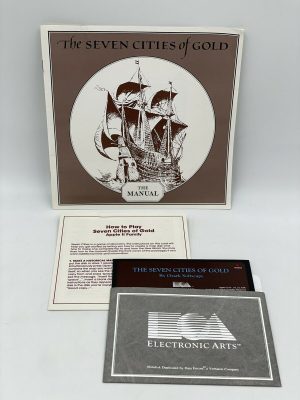
By Patrick S. Baker
1984’s The Seven Cities of Gold (henceforth Seven Cities) is generally acknowledged as one of the most successful and influential early “open-world” video games.
In an open-world video game, the player can wander freely through the virtual world and has significant freedom in choosing how and when to approach the game objectives. In the game a player takes on the character of a 15th-century conquistador, sailing across the Atlantic to the New World to explore, obtain gold and make the Spanish court happy.
The name of the game comes from the legend of the seven cities of gold variously called Cibola, Quivira, or El Dorado. The mythical cities were fabulously wealthy and supposedly located somewhere in what is now the American Southwest.
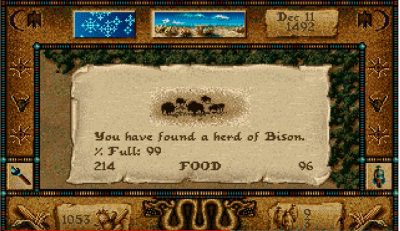 In 1983, Ozark Softscape and Electronic Arts (EA) had just released the award-winning, yet low-selling, multi-player science-fiction game, M.U.L.E. Now the crew from Ozark Softscape was looking to their next project. Ozark Softscape was based in Little Rock, Arkansas, and the primary development team was Dan Bunten, a true genius at game design and main programmer. Dan’s brother, Bill Bunten, Master of Business Administration (MBA), shared design responsibilities with Dan and was the chief play tester. Jim Rushing another MBA and main coder and Alan Watson graphics and animation programmer.
In 1983, Ozark Softscape and Electronic Arts (EA) had just released the award-winning, yet low-selling, multi-player science-fiction game, M.U.L.E. Now the crew from Ozark Softscape was looking to their next project. Ozark Softscape was based in Little Rock, Arkansas, and the primary development team was Dan Bunten, a true genius at game design and main programmer. Dan’s brother, Bill Bunten, Master of Business Administration (MBA), shared design responsibilities with Dan and was the chief play tester. Jim Rushing another MBA and main coder and Alan Watson graphics and animation programmer.
The Little Rock team was joined by Joe Ybarra, their producer from EA, for a week-long brainstorming session. But the Bunten brothers arrived with a pretty good idea of what they wanted the next game to be. Dan explained later in an interview: “When…Bill and I were kids, my uncle gave us a book on the Conquistadors and we thought, Wow!”
Also, “…. there was a strategy board game from SSI, a war-game called Conquistador, (that) was neat, but it was awfully unplayable.” Lastly, “we did not want to do another multi-player game… So, we said. ‘Here’s Conquistador.’” Another inspiration was Avalon Hill’s massive board game Civilization, a huge multiple-player game, that involved war, economics, politics, technology, and culture and which took about eight hours to complete, and that was after understanding the rules. The brothers thought they had a winner of a concept but still had to get the rest of the crew, especially Ybarra on their side.
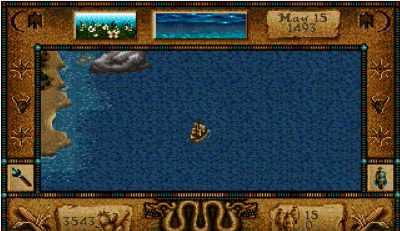
The team played Civilization and while they saw good aspects of it, somehow “computerizing” and packing all the best stuff into a game that could be played on a 48k RAM Atari 800 seemed a bridge too far. Still, Dan was set on making a game with the spirit of Civilization, so the team reeled Dan back in and they decided to jettison war and diplomacy, reduce the colonization to a minimum and focus on exploring and resource collecting aspects of the game.
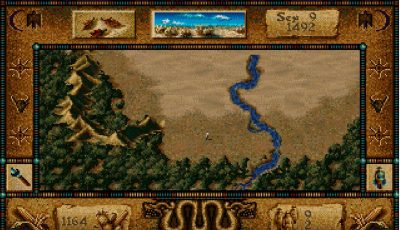
In Seven Cities, the player starts the game with four ships, one hundred men, and some goods supplied by the Spanish crown. On arriving in the new world (either the historical map, or a randomly generated one), the player explores, sets up missions and forts, and deals with the indigenous peoples. Much of the gameplay is inspired by the history of the era. For example, interaction with the natives may be either peaceful, hostile, or turn unfriendly, due to the language barrier.
If things turn hostile the locals are attacked simply by stepping on them. While a few accidental slayings are tolerable to the village, and maybe even inevitable, too many and the locals get to be overtly hostile and attack the party. In most cases, the Spanish can overwhelm the natives and plunder the village.
However, this usually kicks off a nasty guerilla war of raid and ambush between the Indians and the conquistadors. Dan himself said: “The peaceful approach really works best…You’ve got to have some friends somewhere. If something goes wrong, you need a friendly mission where you can go back and not have to worry about an insurrection or something.”
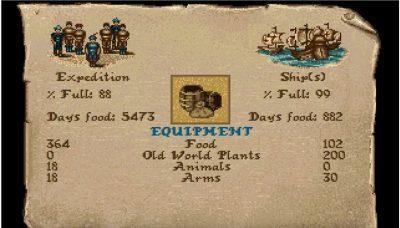 Released in 1984, first for the Atari, and later for the Apple II and Commodore 64, Seven Cities was an immediate sales and critical success. The game sold 100,000 copies in its first year. In September 1984 Compute! Magazine called Seven Cities an “…enhanced strategy game that challenges and educates as well as entertain” and “riveting”.
Released in 1984, first for the Atari, and later for the Apple II and Commodore 64, Seven Cities was an immediate sales and critical success. The game sold 100,000 copies in its first year. In September 1984 Compute! Magazine called Seven Cities an “…enhanced strategy game that challenges and educates as well as entertain” and “riveting”.
Compute!’s Gazette’s January 1985 review called it one of the most interesting games he’d played. Computer Gaming World awarded Seven Cities its “Strategy Game of the Year” for 1985, praising the game’s attention to detail and feel of authenticity.
In 1985, the game was ported to the IBM PC system and the next year to the Amiga and Macintosh. However, Dan Bunten thought the Atari version was the only full version, with the ports being somehow not as good as the Atari version.
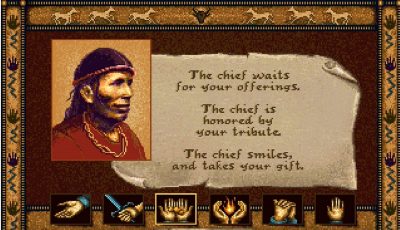
In 1993, a remake of the game was released called Seven Cities of Gold: Commemorative Edition for the IBM PC. This version had much more than updated graphics and sound but was a completely redesigned game. The crew was now explorers, that can uncover more of the map faster, soldiers, who fight better, and clerics, that are needed to establish missions. Trade goods are now diverse, and the player must discover what is most valuable to the Indians.
The resources to take back to Spain are not just gold but also other valuables such as spices and artifacts. The conquistadors can move faster if they bring horses. The combat is harder, and the map has more things to find, like corn, gold, and burial mounds.
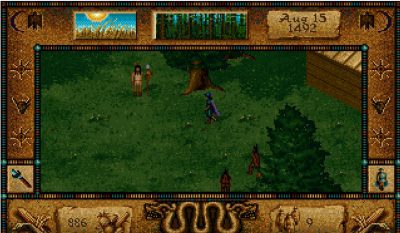
Reviews for the Commemorative Edition were mostly positive with the majority like the Computer Gaming World which called the game “…a perfect combination of elegant design, intriguing subject matter, and solid play balancing…” However, some naysayers said the new features made the game slower and more cumbersome to play. Plus, there was no actual city of gold in the 1993 version. Still, Seven Cities of Gold, Commemorative Edition won the 1993 “Origins Award for Best Military or Strategy Computer Game.”
 In 1996, Computer Gaming World rated Seven Cities of Gold as the sixty-first best video game of all time, calling it: “Ozark Softscape’s fantastic game of New World exploration…”
In 1996, Computer Gaming World rated Seven Cities of Gold as the sixty-first best video game of all time, calling it: “Ozark Softscape’s fantastic game of New World exploration…”
The Seven Cities of Gold was one of the most successful and influential games of all time, inspiring a host of other open-world games such as Civilization and the Fallout franchise.
Patrick S. Baker is a former US Army Field Artillery officer and retired Department of Defense employee. He has degrees in History, Political Science and Education. He has been writing history, game reviews, and science-fiction professionally since 2013. Some of his other works can be found at Sirius Science Fiction, Sci-Phi Journal, Armchair General, and Historynet.com.
Sources:
“Interviewing Dan Bunten” Antic Vol. 3, No. 9 from Jan 1985.
“New Horizons for an Old World”, Computer Gaming World, November 1993
“Open World Video Games” at Codex Gamicus
“Seven Cities of Gold”, The Digital Antiquarian
“Seven Cities of Gold, The”, Hardcore Gaming
“Seven Cities of Gold, The”, Compute! September 1984
“Seven Cities of Gold,” Compute!’s Gazette, January 1985
“Game of the Year”, Computer Gaming World, November–December 1985 and
“150 Best Games of All Time” Computer Gaming World November 1996.
1993 Origins Award Winners Academy of Adventure Gaming Arts & Design.
